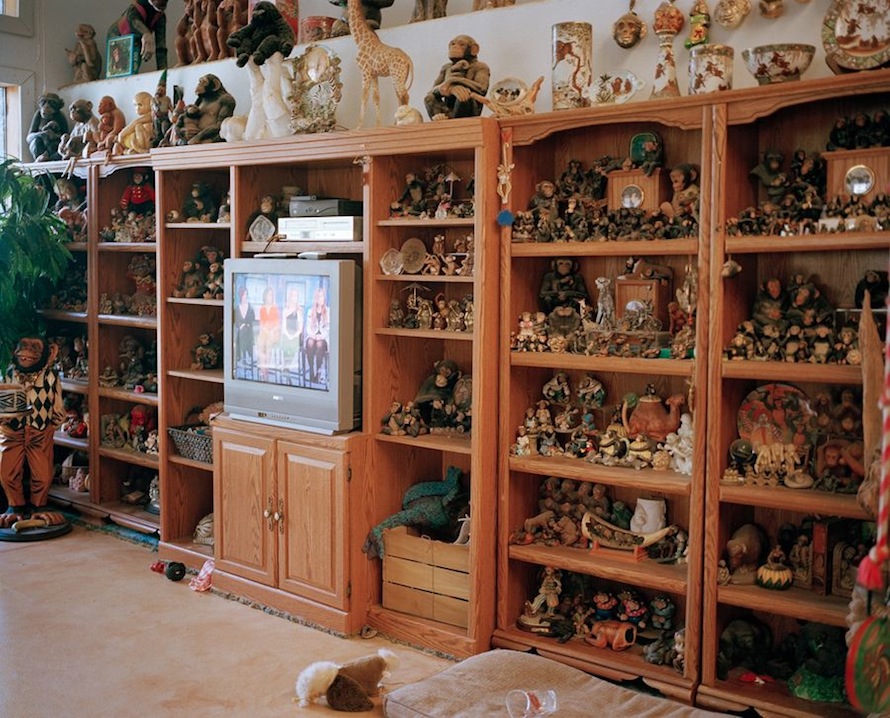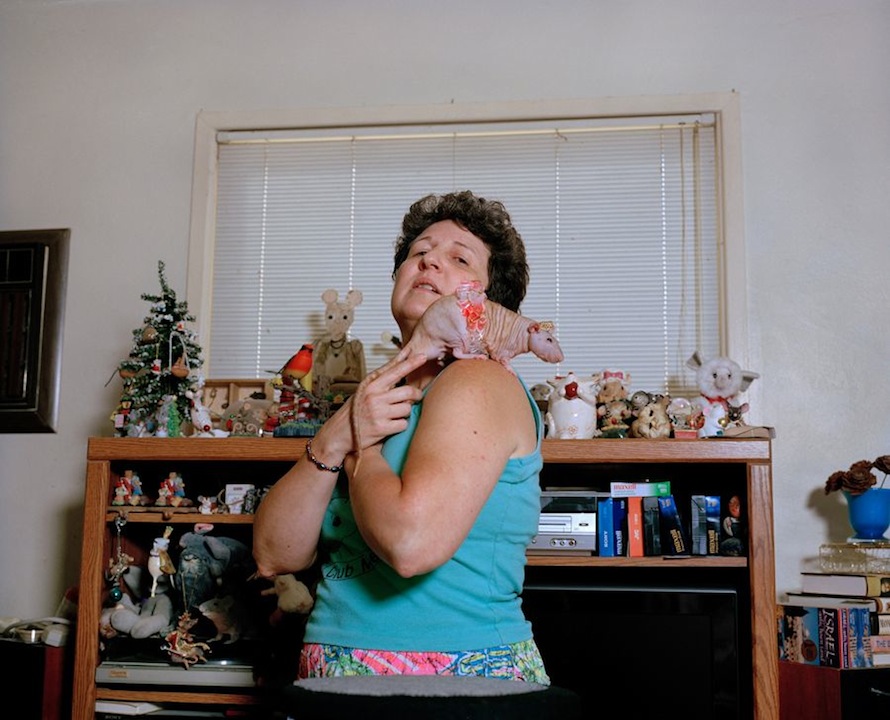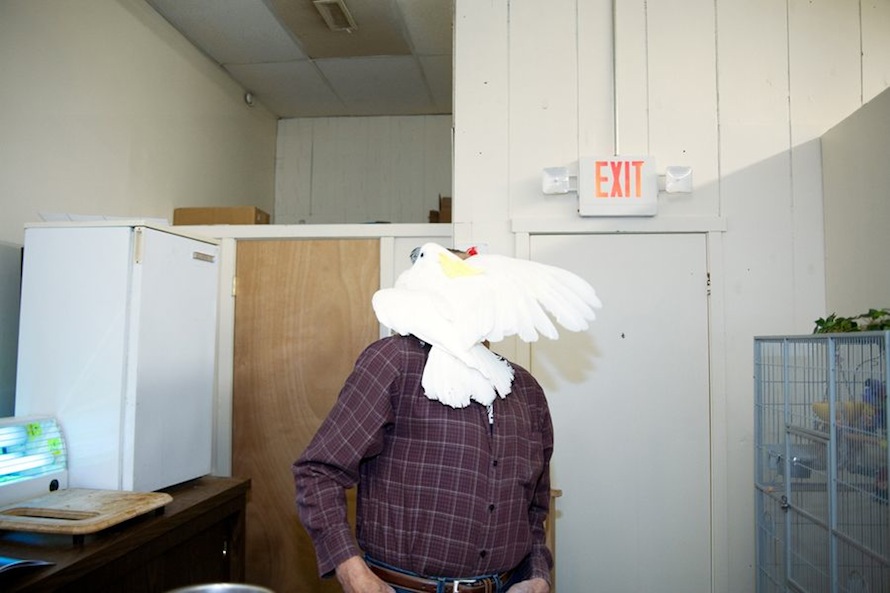Animal Affective
The owners of exotic or unconventional pets in Alex Arzt’s “Human-Animal” photographs range from nurturing to obsessive. Challenging our assumptions about the human and animal worlds, Arzt’s work reminds us that ownership of other species is a uniquely human trait.

Interview by Nicole Pasulka
TMN: In your project’s statement, you make clear these are depictions of real relationships between humans and animals. How do the relationships you’ve photographed compare to those of humans and more common domesticated animals?
Alex Arzt: Human-pet relationships are centered on projections of affection. The line between those projections hovers over the imagined and potentially real. A tiger makes this chortling noise when it’s scratched behind the ears that is kind of like purring, and will even rub up against people and objects like a house cat. The difference is that the owner of the tiger, who owns the lions pictured, knows that there is significant risk in handling big cats so personally. There are these strange continuities between animals, and even between animals and people. Monkeys are especially confusing there.
There’s also this feeling that animals like bears are not supposed to be living in human enclosures because they are wild, noble beasts. The trouble is, we have figured out that the noble beast can be taught to ride a scooter for a few licks of honey. We have an intelligence no other creature has—and that is the ability to teach and train other species. For example, these bears are trained to lick their trainer’s face as a reward after a trick, just like an enormous dog. Do they enjoy it? Who knows? Do racehorses like running? Everything has its own nature and degree of compatibility with ours, and what animals perceive is mostly theory. Continue reading ↓
All images © the artist, all rights reserved.













Interview continued
TMN: Can you even call these animals domesticated?
AA: The main difference is that many of the animals in my photographs are species born in the wild or in captivity and are considered tame. A domesticated animal is one that has been bred selectively over a period of time to meet the needs and desires of humans, such as dogs, cows, goldfish, etc. The wolf I photographed is actually 2% malamute, 98% wolf, so genetically he has a human influence. You can kind of see it in his eyes. Pet rats are also a domesticated species. I think the British started to breed them selectively for rat baiting (when they throw a dog into a pen with a bunch of rats and bet on how many it kills).
TMN: In some instances animals look like accessories or decoration, in other like bosom companions. Is the truth somewhere in between?
AA: Much of it is about identity and community, but also a kind of love. Exotic animals have always conveyed status and wealth. Emperors and kings often had their own menageries of exotic animals. It’s ironic that a lot of the people who own these exotics now spend most of their income taking care of their animals (except Mike Tyson, maybe). But I definitely saw both sides of the spectrum—a sort of obsessive and overwhelming collection of animals and then a selective and well-managed care-taking on the other side. There are clubs in this country for almost any type of animal you can think of—skunk clubs, rat clubs, pigeon clubs. There are clubs for probably every breed of cat and dog. They give people an instant community. The internet, too, offers up a huge ability for animal folks to find each other.
TMN: How do you understand the relationships between people and their pets?
AA: I think there is a little bit of a desire to sort of commune with the beasts also. The way people value different species is pretty interesting. A pig is a very intelligent animal, but also tastes good. A smoosh-faced puppy is adorable and fun, but in practical terms useless. Pet keeping is based on the return of the gaze, of the anthropomorphic belief of mutual human-animal love and companionship. John Berger wrote about how animals offer us a sort of cure to loneliness—a condition arguably only we experience. We live in an age where the market price of a pet might depend on its loyalty, affection, and appearance, traits we might also give to ideal human relationships. All that aside though, I am definitely not immune to an adorable puppy. I fall right into the cute response.
TMN: How did you find these folks and their animals?
AA: Lots and lots of emails, letters, and phone calls. I started contacting animal educators in New England and visiting them. I wrote letters to people all over the US who I found on the internet before my first trip cross country. I went to an exotic animal auction in Ohio after that. I was all over forums and listings for exotic animals for sale. After every trip, I started meeting people through people, as each kind of animal has its own human community. I had to prove myself trustworthy in a community of people whose first priority is protecting the ownership of their animals. Each invitation was a feat and a discovery in itself, and I am grateful for everyone’s hospitality, openness, and kindness.
TMN: Do these relationships begin intentionally or accidentally? How do they develop?
AA: Sometimes, like in Dillie’s case, they are rescues. She is a completely docile creature who roams the house and the backyard freely. She has her own room and bed, is often given treats, is house trained, has a yard to play in, and has a poodle companion. She was born partially blind and sickly on a deer farm and was rehabilitated by her current owner and veterinarian, Melanie. Without humans, she would neither have been born nor would have survived. She even eats dinner with her owners and climbs upstairs to put herself to bed after. It’s amazing how well she has adapted to living in a human home.
Dillie even has her own webcam (she’s kind of famous).
TMN: Do you feel like there’s a difference between having a pet cockatoo and pet lions?
AA: A lion obviously comes with much more risk. Cockatoos are easy to get at pet stores. You can actually buy lion cubs at a few auctions in the Midwest. Laws vary state by state, but in a handful you can get a permit to keep one. People get killed by their pet big cats or bears or monkeys surprisingly often. When I started following this topic, some kind of attack would come up every month or so on the news. But as Americans, we fight for the right to own them and then are perversely fascinated when it goes wrong.
I became very interested in geographies when working on this project. The lions I photographed are African in origin. The cockatoo comes from Australia. But they have been transplanted so many times the lines become blurred as to what belongs where. Cockatoos are surprisingly affectionate. In the photo from Warwick, the bird is actually doing this thing where it makes a little sound and kind of hugs his face.
TMN: What does someone’s exotic or unusual pet say about him or her?
AA: A lot of people form their identity around their animals. One of the people I photographed has a lot of macaque monkeys, most of which are rescues. She slept with her two favorites every night. Her profession is working with children with learning disabilities, and she possesses a steadfast patience. She was like this matriarchal figure watching over all these monkeys. Some of them would get upset if I got close to her.
TMN: What’s your own relationship to animals?
AA: I grew up on a farm in Maryland. We had cows and there would always be one or two that were tame, and my uncle would throw us on their backs when we were little. When I went out in the field all the other cows would run away and there would be one that ran toward you instead. The tame ones were sick as calves so they spent a lot of time with people. I always thought it was amazing that these few cows let us pet them and jump all over them. I think my fascination started there.
